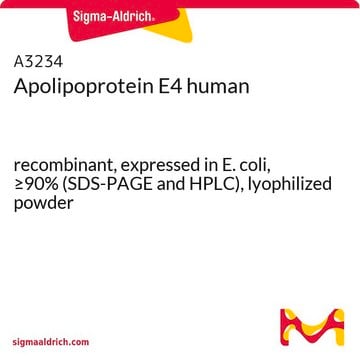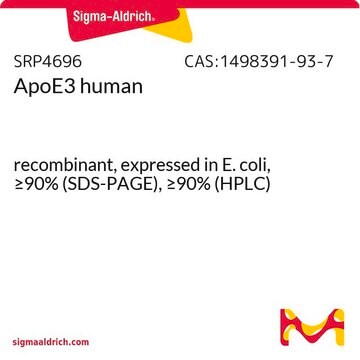SRP4760
ApoE2 human
recombinant, expressed in E. coli, ≥90% (SDS-PAGE), ≥90% (HPLC)
Sinónimos:
Apolipoprotein E2
Iniciar sesiónpara Ver la Fijación de precios por contrato y de la organización
About This Item
Productos recomendados
biological source
human
recombinant
expressed in E. coli
assay
≥90% (HPLC)
≥90% (SDS-PAGE)
form
lyophilized
mol wt
~34 kDa
packaging
pkg of 500 μg
storage condition
avoid repeated freeze/thaw cycles
impurities
endotoxin, tested
NCBI accession no.
UniProt accession no.
shipped in
wet ice
storage temp.
−20°C
Gene Information
human ... ApoE(348)
General description
Apolipoprotein E (ApoE) belongs to a group of proteins that bind reversibly with lipoproteins. Significant quantities of ApoE are produced in liver and brain and to some extent in almost every organ. ApoE is an important constituent of all plasma lipoproteins. ApoE exists in three major isoforms; E2, E3, and E4, which differ from one another by a single amino-acid substitution. Compared with E3 and E4, E2 exhibits the lowest receptor binding affinity. E2 allele carriers have significantly lower levels of total cholesterol, low-density lipoprotein cholesterol, and non-high-density lipoprotein cholesterol, as well as increased ApoE levels. The gene encoding this protein is localized on human chromosome 19q13.32. Recombinant human ApoE2 is a 34.3kDa protein containing 300 amino acid residues.
Biochem/physiol Actions
In addition to facilitating solubilization of lipids, apolipoproteins help to maintain the structural integrity of lipoproteins, serve as ligands for lipoprotein receptors, and regulate the activity of enzymes involved in lipid metabolism. Apolipoprotein E (ApoE) plays an important role in lipid metabolism. It′s interaction with specific ApoE receptor enables uptake of chylomicron remnants by liver cells, which is an essential step during normal lipid metabolism. It also binds with the LDL receptor (Apo B/E). Defects in ApoE are a cause of hyperlipoproteinemia type III.
Physical form
Sterile filtered and Lyophilized without additives.
Preparation Note
Centrifuge the vial prior to opening. Avoid freeze-thaw cycles.
Reconstitution
Reconstitute in dH2O to a concentration of 0.1-1.0 mg/ml. The solution can then be diluted into other aqueous buffers and store at 4°C for 1 week or –20°C for future use.
Disclaimer
RESEARCH USE ONLY. This product is regulated in France when intended to be used for scientific purposes, including for import and export activities (Article L 1211-1 paragraph 2 of the Public Health Code). The purchaser (i.e. enduser) is required to obtain an import authorization from the France Ministry of Research referred in the Article L1245-5-1 II. of Public Health Code. By ordering this product, you are confirming that you have obtained the proper import authorization.
Storage Class
11 - Combustible Solids
wgk_germany
WGK 3
flash_point_f
Not applicable
flash_point_c
Not applicable
Certificados de análisis (COA)
Busque Certificados de análisis (COA) introduciendo el número de lote del producto. Los números de lote se encuentran en la etiqueta del producto después de las palabras «Lot» o «Batch»
¿Ya tiene este producto?
Encuentre la documentación para los productos que ha comprado recientemente en la Biblioteca de documentos.
Brynne E Whitacre et al.
Journal of lipid research, 63(1), 100157-100157 (2021-12-06)
High levels of circulating triglycerides (TGs), or hypertriglyceridemia, are key components of metabolic diseases, such as type 2 diabetes, metabolic syndrome, and CVD. As TGs are carried by lipoproteins in plasma, hypertriglyceridemia can result from overproduction or lack of clearance
Apolipoprotein E-low density lipoprotein receptor binding: study of protein-protein interaction in rationally selected docked complexes.
Prevost M and Raussens V
Proteins: Structure, Function, and Genetics, 55(4), 874-884 (2004)
Apolipoprotein E isoforms and lipoprotein metabolism.
Phillips MC
IUBMB Life, 66(9), 616-623 (2014)
Genome-wide association study identifies a single major locus contributing to survival into old age; the APOE locus revisited.
Deelen J
Aging Cell, 10(4), 686-698 (2011)
Fatemeh Nouri Emamzadeh et al.
Neuroscience letters, 618, 146-151 (2016-02-28)
Parkinson's disease is a progressive brain disorder due to the degeneration of dopaminergic neurons in the substantia nigra. The accumulation of aggregated forms of α-synuclein protein into Lewy bodies is one of the characteristic features of this disease although the
Nuestro equipo de científicos tiene experiencia en todas las áreas de investigación: Ciencias de la vida, Ciencia de los materiales, Síntesis química, Cromatografía, Analítica y muchas otras.
Póngase en contacto con el Servicio técnico








